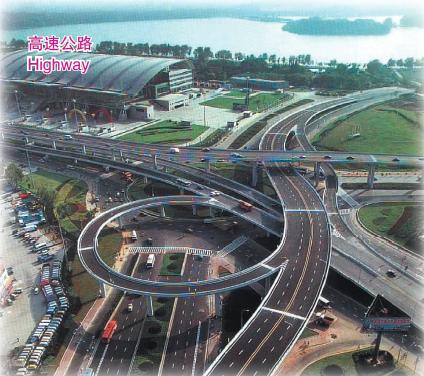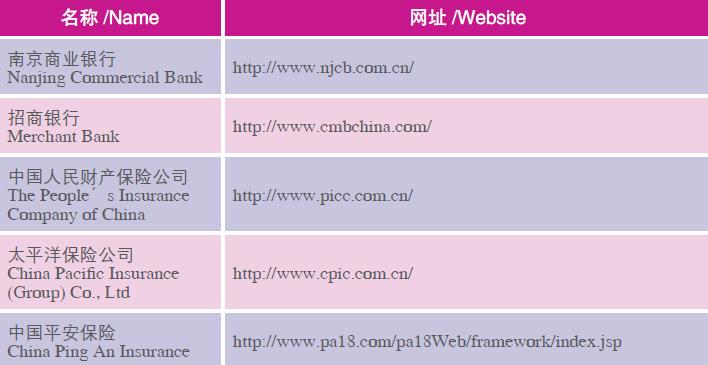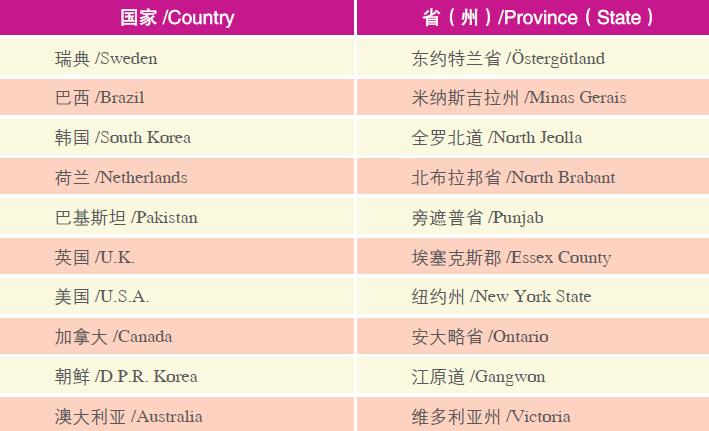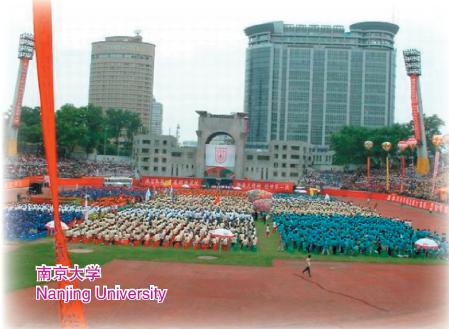Speech by the Governor
Jiangsu is located in the beautiful Yangtse River Delta, crossing the Yangtse River and bordering the sea. It is an economically developed province and a talent hub. Since the Reform and Opening up, Jiangsu's economy has developed sustainably, rapidly and healthily. Its GDP takes up 1/10 of the country's total, while its per capita GDP exceeds US$3,500. Jiangsu has entered the important development stage of the industrialisation's transformation, urbanisation's acceleration, marketisation's optimisation, and internationalisation's progress. Jiangsu has convenient transportation, superb infrastructures and excellent investment climates. It has already completed an expressway network throughout the province and has a large density of river and sea ports, with annual handling capacities exceeding 800 million tons. Jiangsu has a strong scientific and educational base. It has 115 universities and colleges and 1.25 million college students, both ranking 1st in the country. Jiangsu has established trading ties with 218 countries and regions, with the import and export total exceeding US$280 billion in 2006. There are already over 60,000 foreign-invested enterprises in the province accumulatively. An overall multi-area and multi-level opening pattern has taken shape and makes Jiangsu one of the most dynamic areas in China. We will make further efforts to create competitive investment climates and provide better quality services to friends from home and abroad undertaking cooperation and making investmets in Jiangsu for win-win results and mutual development.
Governor of People's Government of
Jiangsu Province
Liang Baohua
(i) Location
Jiangsu province, as short as Su, is located in the middle of the east coast of China between Longitude East 116°18' and 121°57', Latitude North 30°46' and 35° 07'. It lies within the lower reaches of the Yangtze River and the Huai River, and is adjacent to the Yellow Sea on the east, to the Anhui province on the west, to the Shandong province on the north, and to the Zhejiang province and the Shanghai city on the south. It covers an area of 102.6 thousand square km, about 1.06% of the total area of China, ranking the 24th. The province has a fl at terrain, which has vast plains without big mountains. Jiangsu has numerous lakes and a dense network of waterways. With some hills in the northern part and the southwestern part, Jiangsu has a large area of plain mainly consisting Jianghuai (the Yangtze River and Huai River) Plain, Huanghuai (the Yellow River and Huai River) Plain, Eastern Seashore Plain, and Yangtze Delta from north to south. The plain area of Jiangsu is 70.6 thousand square km, about 68.9% of the total area of Jiangsu; the water surface area is 17.3 thousand square km, about 16.8%; the hill area is 14.7 square km, about 14.3%. Located in the suburb of Lianyungang, the Yunnv apex, Yuntai Mountain, is 625 meters above the sea level, the top one in Jiangsu. It has large percent of plain area and water area, and less percent of hill area, which all ranking the first in China and giving Jiangsu the reputation of" Region of Rivers and Lakes".
Main Cities
There are 13 municipalities under the jurisdiction of the provincial government, namely, Nanjing, wuxi, xuzhou, Changzhou, Suzhou, Nantong, Lianyungang, Huai'an, Yancheng, Yangzhou, Zhenjiang, Taizhou, and Suqian. Under these municipalities, there are 106 counties or county-level cities, including 27 country level cities, 25 counties, and 54 districts. The capital of the province is Nanjing.
(ii) Climate
Situated in a transition belt from a subtropical to temperate zone, Jiangsu has a mild climate, with a cold winter, a hot summer and distinguished seasons. January is the coldest month of the year, and July is the hottest one. The average temperature of Jiangsu Province descends from north to south, which is about 13℃ -16℃. Affected by the East-Asian Monsoon, it has more rainfall in the summer than in the winter. The average rainfall is about 1,000 mm.
(iii) Population & Nationalities
Jiangsu has a population of 74.745 million, in which 3,746 million are residents of cities or towns. There are 55 minority nationalities in Jiangsu, with a population of 260 thousand, about 0.36% of the total population of the province. And 51% of the people of minority are Hui Nationality.
(iv) Infrastructure and Transportation Facilities
Jiangsu has a colligated transportation network, including railway, highway, waterway, airline, and duct transportation, connecting in and out the province. The mail and telegram of the province are developed, which has constructed the network of electricity, microwave, shortwave, satellites, mobile phones, and digital telegram.
Airport
7 cities in Jiangsu have airports. Domestic airlines can connect all big and middle cities in the country. The international airlines can go to America, west Europe, and Africa. Nanjing Lukou International Airport is the main civil airport in China, and the main cargo airport in the East China, which has 85 airlines in or out of the country and can land and take off all big airplanes of all models. Now, it has the passenger airlines connecting with Hong Kong, Macao, also Taibei and Gaoxiong transferred at by Macao, Kuala Lumpur, Bangkok, Nagoya and Seoul; the cargo airlines connecting with Winnipeg, and Moscow. In 2005, Nanjing Lukou International Airport handled 5.1 million passengers, 165 thousand tons of cargo, having fulfilled 55,000 stories air transportation.
Railway
The railway network in Jiangsu can connect with more than 40 big and middle cities in the country. There are two railway hinges, namely, Nanjing and Xuzhou, and three railways, namely, the railway from Beijing to Shanghai, the one from Nanjing to Wuhu, and the one from Lianyungang to Urumchi. Since 1992, starting from Lianyungang on the east and ending by Rotterdam on the west, the New Asia-Euro Continental Bridge, which is a convenient and economic transport channel of Asia- Europe joint sea-and-rail transportation with a length of 10,900 km, takes more than 95% international railway transportation. Moreover, Lian Yungang is given the name of " East Bridgehead" of New Asia-Euro Continental Bridge.


Highway
Centered in Nanjing, Jiangsu has constructed a dense highway network to all cities, counties and towns. The main highways are expressway, the first level highway, and the second level highway in the province and some high level way connecting with other provinces. By the end of 2005, the total provincial expressway reaches 2,886 km, ranking the third in the length of China.
Harbor
Jiangsu has 11 opened up harbor of class I, such as the Lianyungang Harbor, the Nanjing Harbor, the Nantong Harbor, and etc, and 128 berths of 10-thousandton level, which can be opened for the foreigners, with the throughput of the import and export volume of about 114 million tons. The Lianyungang Harbor is one of 8 biggest harbors in the country, and the most economic and convenient harbor for the middle and northwest china. The Nanjing harbor is the biggest freshwater harbor in Asia with the throughput of more than 100 million ton, which connects with 160 harbors in 76 countries and regions.
Shipping
Jiangsu's freshwater shipping has a special geographic advantage. For about 400 km route, a part of the Yangtze River, across the province from west to east; and about 690 km route, a part of the Great Canal, across the province from north to south. It has 24,793 km freshwater route in the province, about 18.4% of the total of the country. It has 7,546 km route above level 7 and 1,781 km route above level 4, taking up 7.2% of the total of the province, and 11.8% of the total one above the level 4 of the country. Both the number and the length of the route are the first in the country.
The middle and lower reaches of the Yangtze River across the province, and the Yangtze River bridges are the main channels for connecting the north and the south. The Yangtze River bridges in the province have their own characters. The Nanjing Yangtze River Bridge is the combined highway and railway bridge, which is designed and constructed by ourselves; the Jiangyin Yangtze River Bridge is the first in the country and the fourth in the world of the span in the kind of the suspension bridge; the No.2 Nanjing Yangtze River Bridge, which is 21.197 km long, and its main span is 628 meter, is the first one in the similar bridge in the country and the third one in the world; the Runyang Yangtze River Bridge, which is 35.66 km long, is the first grand bridge combined by the cable stayed bridge and the suspension bridge.
Finance
In 2005, Jiangsu has 9,662 finance units, such as state-owned bank, policy-related bank, other business bank, urban business bank, rural business bank, urban credit cooperative, rural credit cooperative, and etc.
Insurance
There are 29 insurance companies, 4,033 branches, and 150 thousand staff in the field of insurance in Jiangsu now. The insurance income of the province was 43.734 billion yuan in 2005, about 8.9% of the total one of the country. The property insurance income was 9.75 billion yuan, and life insurance income was 33.984 billion yuan.

Post and Telecommunication
Jiangsu has built the long-distance transfer network, which is made by the optical cable as the main one and the digital microwave as the supplement, and realized the programmed controlled exchanging and transferring by the digital of the village level. The mobile phone signal has covered the whole province, and the mobile phone can be cruised all over the country. The operation of the digital telecom and the multimedia telecom appears continually. The integrated telecom ability of the province is the second of the country. Advanced information and technology networks, such as the public information network, the intelligentized network, the optical cable network, digital updated network, information administration network, and etc, have been used widely in Jiangsu. In 2005, there were 56.133million telephone subscribers in Jiangsu with 30.591million fixed-line ones and 25.542million mobile ones, reaching a popularizing rate of 75.6 per hundred people. There were 1.58 million internet dial-up subscribers and 2.908 million broadband ones.
(v) Foreign Exchanges
International Sister Provinces and States, and Sister Cities
Jiangsu has developed the foreign exchanges for many years, and had built the friendship with dozens of the countries in all fields, levels, and forms. By the end of 2005, Jiangsu province has 166 pairs of sister city, 23 pairs of sister province or state, which promote the exchanges with the foreign countries in all fields, such as economy, science and technology, culture, education, public health, sport, tourism, environmental protection, and etc, increasing the understanding and friendship between each other, and putting forward the common development and progress.


Foreign Expo
There are numerous international business activities in Jiangsu, such as, Nanjing Golden Autumn Economic and Trade Fair and Suzhou Electronic Information Expo, Jiangsu Export Products Expo (Japan), Jiangsu Export Products Expo (Sri Lanka), Jiangsu Export Products Expo (Tanzania), Jiangsu Export Products Expo (Nigeria), and etc.
China Nanjing Golden Autumn Economic and Trade Fair: it is held from the end of September to the beginning of October each year in Nanjing, which has become a well-designed brand by Jiangsu to attract investments since the 1st fair held in 1990.
Suzhou Electronic Information Expo: it is held in October each year in Suzhou, the largest-scale IT Expo.

(vi) Higher Education and
Scientific Research In 2005, Jiangsu houses 115 colleges and universities including well-known universities in the top rank of China, namely Nanjing University, Southeast University, Nanjing Normal University and Nanjing University of Aeronautics and Astronautics. There are 1.2377 million registered students, 120,440 faculties, and 67,334 teachers; 150 technical secondary schools, with 661 thousand registered students, 20,987 faculties, and 14,240 teachers.
In 2005, there are 3,584 scientific research and technological development institutions in Jiangsu with 355,000 workers engaged in scientific activities, among whom 100,500 are research and development workers, and 94 academicians of Chinese Academy of Science and Chinese Academy of Engineering. Jiangsu Province has established 166 state or provincial level high-tech research key laboratories, engineering research centers and public sci-tech service platforms. In 2005, 32 achievements in Jiangsu received National Science and Technology Awards, 34,811 Patent Applications were raised with 13,580 approved.
(vii) Tourism

Scenic Sports and Historical Sites
Jiangsu, with its hills, lakes, springs, gardens, and temples, has been an ideal destination for tourists since ancient times, with 16 cities been awarded with the title of China Excellent Tourism City. The scenery of Taihu Lake is the most beautiful one in five big freshwater lakes. Other lakes, such as Xuanwu Lake and Mochou Lake in Nanjing, Shouxihu Lake in Yangzhou, Yangcheng Lake in Suzhou, Yunlong Lake in Xuzhou, Tianmu Lake in Liyang, have their own characters. There are some scenic spots with the title of China's AAAAlevel Tourists Attractions, such as Confucius Temple in Nanjing, Huqiu i Suzhou, Yuantouzhu in Wuxi, Tianning Temple in Changzhou, Red-crowned Crane Nature Reserve Park in Yancheng, and etc. Jiangsu is famous for its traditional gardens, as Humble Administrator's Garden and Lingering Garden in Suzhou are of the four most famous gardens in China. Nine traditional gardens in Suzhou, which named as' heaven in the world', have been inscribed by UNESCO on the World Heritage List. In July 2003, Nanjing Mingxiaoling Mausoleum has been inscribed on the World Heritage List, too. And there are some famous temples, such as Xixia Temple in Nanjing, Jinshan Temple in Zhenjiang, Daming Temple in Yangzhou, Hanshan Temple in Suzhou, Longchang Temple in Jurong, and etc.
Zhongshanling Zhongshanling is the mausoleum of Dr. Sun Yat-sen, great forerunner of China's democratic revolution. It is situated on the southern slope of Xiaomaoshan, eastern hill of Purple Mountain in eastern suburbs of Nanjing, Jiangsu, adjoining Xiaoling Tomb of the Ming Dynasty in the west and Linggu Temple in the east. The whole architectural complex ascends by the mountain, full of power and magnificence. The mausoleum is shaped like an alarm bell with the meaning of" awakening the nation to found a Republic of China".
Xiaoling Tomb of Ming Dynasty
Xiaoling Tomb of Ming Dynasty is the tomb of the first Emperor of Ming Dynasty, Zhu Yuanzhang and his queen. It is located at the foot of Wanzhu Hill of Dulongfu of southern Purple Mountain, adjoining Zhongshanling in the east and Plum Blossom Hill in the south. It is the biggest emperor's tomb in Nanjing and one of the biggest in China.
In July 2003 Xiaoling Tomb of Ming Dynasty was formally added to World Heritage List on the 27th World Heritage Conference.
Suzhou Gardens there are over 10 well-known gardens in Suzhou, namely Canglang Pavilion, Lion Forest Garden, Humble Administrator's Garden, Lingering Garden, Master-of-Nets Garden, Joyous Garden, etc. The coverage of Suzhou Gardens is small. However, within the limited area, Suzhou Gardens integrate spice of Chinese traditional paintings into artistic conception of Tang Poetry and Song Ci, which are interspersed with rockeries, trees, pavilions and vlies so that an artistic effect of multum in parvo is attained.
Special Arts and Goods
The traditional arts in Jiangsu are various and excellent skilled. Nanjing Yun Brocade and Suzhou Song Brocade are the two of three famous brocades in China. Wuxi Huishan Pottery Figure is the treasure of the colorful sculpture in China, and its masterpiece is the Daafu. There are also some other arts brighten Jiangsu traditional culture, such as Yixing Chinaware, Huqiu Pottery Figure, Nantong Kite, Yangzhou Jade Scuplture and Lacquer, Changzhou Comb, Suzhou Embroidery, Changzhou Comb, Suzhou Sculpture Picture Special for the Spring Festival, and etc. Nanjing Yuhua Stone, Donghai Crystal, and Taihu Lake Pearl are valuable and good for collection.
Special Foods
Jiangsu has various special foods. The history of the Nanjing Ban Duke is more than 500 years; the Zhenjiang Vinegar has a deep color and a sweet-smelling taste; the Biluochun Tea is one of ten famous teas in the country, and the best of green tea; the Yancheng Lake Crab is the king of the freshwater crab; the Lianyungang Dongfang Prawn has lots of nutriment. Jiangsu has some famous special foods, such as the Taixing Huangqiao Pancake, the Xuyi Lobster, the Peixian Dog's Meat, the Dongtai Noodle with Fish Soup, the Kunshan Aozao Noodle, the Yangzhou Fuchun Steamed Dumpling, the Su-style Rice Candy, the snacks in Confucius Temple nearby the Qinhuai River, and etc.
Doing Business in Jiangsu Province of China:II.Economy
Doing Business in Jiangsu Province of China:III.Investment
Doing Business in Jiangsu Province of China:IV.Development Zones





